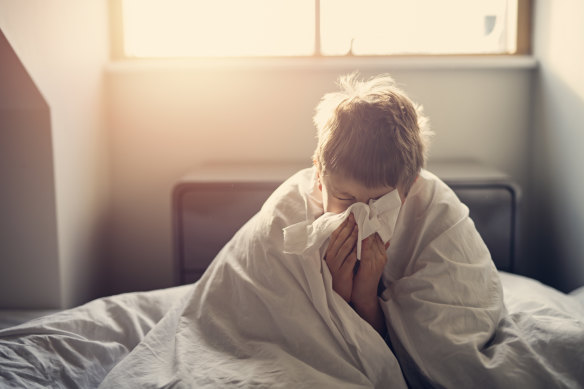A storm of pneumonia, flu, whooping cough and COVID-19 is surging rapidly across NSW as emergency departments brace for a punishing winter of respiratory illnesses.
More than 550 children from babies to 16-year-olds presented to emergency departments in the week ending June 1, the latest NSW Health respiratory surveillance report shows. Almost 400 were aged five to 16, a 25 per cent increase in one week.

Almost 400 children aged 5 to 16 presented at emergency departments with pneumonia in the week ending June 1. Credit: iStock
The rising trajectory of pneumonia presentations on the cusp of winter was “unseasonably high” for children and young adults, the report read.
The surge was probably due to the bacterial infection Mycoplasma pneumoniae which spreads in crowded environments and damages the lining of the lungs, throat and windpipe.
Mycoplasma epidemics happen every three to five years, but infectious diseases experts say the latest outbreak seemed more pronounced.
The number of confirmed influenza cases rose by 30 per cent to 5324 in the week to June 1, and emergency department presentations had also risen.
Dr Rebekah Hoffman, chair of the NSW and ACT branch of the Royal Australian College of General Practitioners, said: “There is a really significant increase in the numbers of pneumonia and influenza cases in the community this season.
“We expect [a surge in cases] on a seven to 10-year cycle, but unfortunately, this year has hit us with a number of other viruses as well as it being post-COVID.”
With the combination of circulating bacterial and viral infections spreading through the community, there was a higher risk that people would succumb to back-to-back infections, significantly increasing the chances of more severe illness and hospital presentations, Hoffman said.
“If you catch influenza, then you catch mycoplasma then you catch rhinovirus you are much more likely to be significantly unwell,” she said.
‘We have a surge of influenza … but there’s also this secondary risk [when it’s combined] with bacterial infections,’
Paedeatric infectious deseases expert Dr Robert Booy
Robert Booy, honorary professor at the University of Sydney and paediatric infectious diseases expert, said influenza laid the groundwork for invading bacterial infections such as mycoplasma and pneumococcus to progress to pneumonia.
“So we have a surge of influenza causing immediate issues, but there’s also this secondary risk [when it’s combined] with bacterial infections,” Booy said.
Whooping cough (pertussis) has more than quadrupled in four months, with 1215 cases recorded in May (including 80 in children under five years old) compared to 275 cases in February.
The bacterial infection can cause pneumonia and be life-threatening, especially for babies, and NSW Health has warned that the upward trend will probably continue.
The pertussis vaccination reduces the risk of infection and severe disease, and Australia has high vaccination coverage. But Hoffman said outbreaks occur every few years as population immunity wanes, and there are geographical pockets where vaccination rates fall below 80 per cent, for example in northern NSW, Hoffman said.
“We vaccinate our kids, but then people might not get vaccinated again until they fall pregnant or their loved ones do, and then they realise that they haven’t been vaccinated [against pertussis] for 20 years,” she said.
Booy said the surge in pertussis was no surprise as the population reemerged from almost two years of social distancing and renewed its socialising in large crowds.
“We are combining more susceptibility [to infection] with more opportunity for transmission,” Booy said. “This is true of pertussis, mycoplasma and pneumococcus the classic cause of pneumonia.”
There were 5223 new COVID cases in the last recorded week, almost 1000 more than the previous week, a 22 per cent increase, most notably among the elderly.
Meanwhile, rates of respiratory syncytial virus were declining but remained high.
“Just because it’s down doesn’t mean it’s gone,” Booy said. “You would be naive to think it’s no longer a risk. There are still new cases every week,” he said of the potentially serious illness that can also cause pneumonia in children.
Start the day with a summary of the day’s most important and interesting stories, analysis and insights. Sign up for our Morning Edition newsletter.